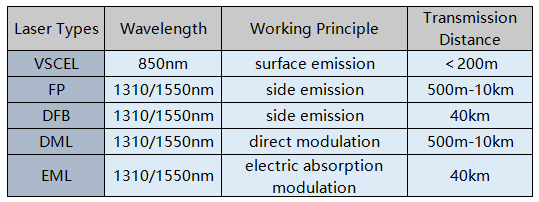

Sort by :Price: Low to High
Categories
{{cate.name}}
view {{page_size}}
100G QSFP28: differences and selection of SR4/LR4/PSM4/CWDM4/ER4/ZR4
With the development of 100G Ethernet, the demand for the 100G transceiver market is increasing. At present, 100G transceiver accounts for a large proportion of the cost of network construction. Among these optical modules connecting 100G links, 100G QSFP28 is the first choice because of its small size and low power consumption.
So, what are the types of 100G QSFP28 optical modules? What is the difference between them? How to select these modules? This article will tell you in detail.
The 100G QSFP28 optical module is suitable for 100G Ethernet, EDR Infiniband and 32G fibre channel. Generally, its size and panel density are the same as 40G QSFP+. The 40G QSFP+ uses four 10Gbps channels, and the 100G QSFP28 module is similar. Four high-speed differential signal channels are adopted, and the data rate supports 25Gbps, up to 40Gbps. In addition, the 100G QSFP28 has an upgraded electrical interface and can support signals up to 28Gbps. The main types are: QSFP28 SR4, QSFP28 LR4, QSFP28 PSM4, QSFP28 CWDM4 and QSFP28 ER4. Compared with other package types of 100G transceivers (CFP/CFP2/CFP4), the 100G QSFP28 has higher density, lower power consumption and obvious price advantages.
After understanding the basic concept of 100G QSFP28, this section will explain in detail the differences of 100G QSFP28 transceiver in terms of standard, laser type, transmission medium and distance.
The standard of 100G QSFP28 optical module is mainly defined by IEEE and MSA, in which IEEE defines the standards of QSFP28 SR4, QSFP28 LR4 and QSFP28 ER4. "QSFP" means the packaging(form-factor) of the optical module; "28" indicates that the maximum transmission rate of each channel is 28Gbps; "SR" means short distance (up to 100m), "LR" means long-distance (up to 10km), "ER" means super long-distance (up to 40km); ' "4" means that the module has four channels. For example, QSFP28 LR4 means that the 100G remote module can transmit 100G signals of four wavelengths, and the maximum distance can reach 10km.
As mentioned before, 100Gbase-SR4 and 100Gbase-LR4 are the two most common 100G port specifications defined by IEEE. However, the transmission distance of QSFP28 SR4 is too short to meet all connection requirements, and the cost of QSFP28 LR4 for large data centers is too high.
Fortunately, MSA has brought a new solution to the medium distance transmission market: QSFP28 PSM4 and CWDM4 standards have been born. Although QSFP28 LR4 is similar to QSFP28 CWDM4, the CWDM4 transceiver with a transmission distance of 2km is cheaper and more competitive than the LR4 transceiver in terms of cost.
Laser plays an important role in 100G QSFP28 optical module. There are five common lasers: VCSEL, FP, DFB, DML and EML. These different types of lasers have different working wavelengths, working modes and application environments.

VCSEL lasers are characterized by small size, low power consumption, easy integration, low cost, and high coupling efficiency with multimode fibers. This is common in QSFP28 SR4 modules. Since the QSFP2828 LR4 and ER4 modules are used for long-range transmission (10km or 40km), which require lasers with large line-of-sight, low dispersion, high extinction ratio and long transmission distance. The EML lasers can fully meet all these requirements. Then, the DML lasers can achieve signal modulation by modulating the laser's injection current. Because the injection current changes the refractive index of the laser source region, resulting in wavelength drift and dispersion. Therefore, DML is not suitable for long-distance transmission and cannot achieve high-speed signal modulation, but it is suitable for QSFP28 PSM4 and QSFP28 CWDM4 modules with a transmission distance of 500m or 2km.
The 100G QSFP28 optical module is equipped with a duplex LC or MTP/MPO-12 connector, and the transmission distance ranges from 70m to 40km. The transmission distance of these optical modules determines their application scenarios—All QSFP28 modules can be used for the direct connection and interconnection of enterprise networks or data centers. The following table details the differences between them.

After introducing different types of 100G QSFP28 modules, I believe you have a basic understanding of these modules. Next, let's talk about how to select 100G QSFP28 transceiver.
· When the transmission distance is 5m-100m, it is recommended to select the QSFP28 SR4 optical module. The transmission distance of such modules is 70m on OM3 optical fiber and 100m on OM4 optical fiber.
· When the transmission distance is 100m-2km, QSFP28 PSM4 or QSFP28 CWDM4 module can be selected. The unit price of CWDM4 is generally higher than that of PSM4, but CWDM4 only needs two single-mode fibers for bidirectional transmission, while psm4 needs eight. Therefore, the overall cost of using QSFP28 PSM4 may be higher. Therefore, in practical application, you need to consider the specific transmission distance, and then decide which module is appropriate.
· When the transmission distance is 10km-40km, 100G QSFP28 ER4 or QSFP28 LR4 can be selected. The former can transmit up to 10km and the latter can transmit up to 40km.
Generally, 100G QSFP28 has the characteristics of high density and low power consumption. It can not only meet the current network needs but also prepare for future network expansion. It is an ideal optical module scheme for large data centers. Fiber Mall provides various high-performance 100G QSFP28 optical modules. All modules are strictly tested to ensure product quality and compatibility.